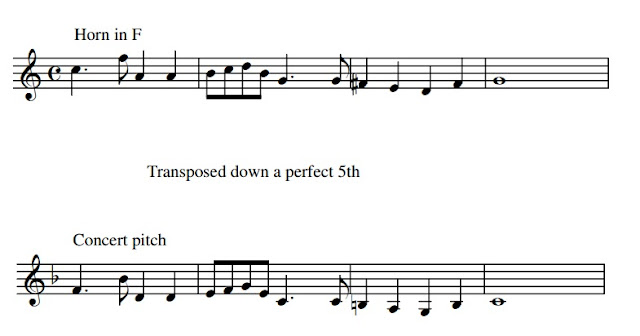Workbook (NEW for 2021) with answers HERE
Up until now you have only had to transpose a melody up or down an octave. There are many Orchestral Instruments which are called transposing instruments. This means that they play things at a different pitch to what they read. For example, a French Horn would read the note "E" but be playing an "A" in what we call concert pitch. This all sounds a bit complicated and daunting but if you follow a few simple rules it is not that bad.

Applying points 1-4 above:
Sometimes you might be asked to transpose without a key signature. In this case
....pretend you're in C major
....work out your new transposed key (in the above example - F major)
.... instead of using a key signature just keep the accidentals of your new transposed key in your mind. In the above example it will be F major, i.e. a B flat.
This is how the answer will look for a question that asks you to transpose without a key signature

Most questions will require you however to change and use a key signature.
- Firstly you will be told in the exam how far to transpose the melody for a given transposing instrument (you don't have to work that bit out yourself), for example up a perfect fifth or down a minor third.
- Next you need to transpose your key signature. If you were told to transpose everything down a minor 3rd and you were given a key signature of A flat major, you write the key signature a minor third down from A flat, that is F major.
- Then simply write each note an interval of a third lower than what you are given. You don't really have to worry about the "minor" bit of minor 3rd, because the key signature should take care of that.
- Where there are accidentals - if the given note has been raised or lowered then you need to do the same to the transposed note.
Consider this example:

Applying points 1-4 above:
- You are told to transpose down a perfect 5th
- Transpose the key signature (in this case C major) down a 5th to become F major
- Write each note a 5th lower
- Account for any accidentals, so for example, the F sharp in the 3rd bar has been raised from the original, so you need to raise the corresponding note in the transposed version. In this case a B flat is raised to a B natural.
Sometimes you might be asked to transpose without a key signature. In this case
....pretend you're in C major
....work out your new transposed key (in the above example - F major)
.... instead of using a key signature just keep the accidentals of your new transposed key in your mind. In the above example it will be F major, i.e. a B flat.
This is how the answer will look for a question that asks you to transpose without a key signature

Most questions will require you however to change and use a key signature.
Practice this topic with our workbook
"Music Theory Practice - A Complete Course"
New for 2021



When the French Horn reads E but plays A, is that at a higher pitch?
ReplyDeleteWhen the French Horn plays the E, is the sound produced at a higher register?
ReplyDeleteNo, it is the A below
ReplyDelete